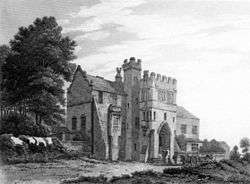Charles Heath



Charles Theodosius Heath (1 March 1785 – 18 November 1848) was an English engraver, currency and stamp printer, book publisher and illustrator.
Life and work
Heath was the illegitimate son of James Heath, a successful engraver who enjoyed the patronage of King George III and successive monarchs. He received his first training in the art from his father and his first known etching dates from when he was six years old. It was from his father that he learnt how to produce small plates suitable for book illustration. Early in life he became a fellow of the Society of British Artists, and contributed for some years to their exhibitions.[1]
An entrepreneur who first mass-produced steel engravings in Britain for the purpose of illustration, he was a driving force behind, and contributor to, the new genre of the literary annual. His business ventures were the first English publications (and currency, stamps, etc.) to use the new method of steel etching printing patented by Jacob Perkins. Charles Heath established his own literary annual, The Keepsake, in 1827, and tried to persuade Sir Walter Scott to become its editor. His productions were very successful, but he often had difficulty managing his finances, and in the 1840s he had to sell much of his stock to stay afloat.
Heath owned a large studio, and a great deal of the work signed "Heath" is not actually by him; nevertheless he was very prolific. He was related by marriage to Henry Corbould, with whom he also had a business relationship. Charles Heath (as engraver), George Heath (financial-backer and halfbrother) and Henry Corbould (designer) printed money and various stamps for multiple governments. Heath's published books are still being reprinted today.
Heath married his cousin Elizabeth Petch. Two of Heath's sons, Frederick (1810–1878) and Alfred (1812–1896), were engravers and one, Henry Charles Heath (1829–1898), was a miniature painter who portrayed Queen Victoria and other members of the royal family.[2] Among Heath's pupils were George Thomas Doo (1800–1886), William Henry Mote (1803–1871), and James Henry Watt (1799–1867).[1]
Rights of engravers
Charles Heath believed that custom entitled engravers to make and keep a limited number of impressions of their work. When he was sued by the publisher, John Murray, in 1826, as a result of having made and kept such impressions, he relied on that supposed custom, but, in 1830, a jury denied its existence. Then, in 1831, the judges of the Court of King's Bench held that his conduct had been unlawful at common law, though not a breach of the Prints Copyright Act 1777.
The government disapproved when the same concept was applied to stamps, and punished the company Perkins Bacon by stopping their printing of the stamps briefly. Charles Heath had encouraged Jacob Perkins to come to England and cofounded an English company with him; the company name was changed when Joshua Butters Bacon bought out the Heath interest in the company.
Notes
- 1 2 Stephen, Leslie; Lee, Sidney, eds. (1891). "Heath, Charles (1785-1848)". Dictionary of National Biography. 25. London: Smith, Elder & Co. pp. 340–1.
- ↑ Charles Heath biography.
Bibliography
- Keppel Richard Craven & Charles Heath. A tour through the southern provinces of the Kingdom of Naples (London: Rodwell and Martin, 1821)
- Auguste Pugin & Charles Heath. Paris and its environs: displayed in a series of two hundred picturesque views, from original drawings: Volume 1, Volume 2 (London: Jennings and Chaplin, 1831).
- Charles Heath. The Shakespeare gallery: containing the principal female characters in the plays of the great poet (London: C. Tilt, 184?).
- Charles Heath. The heroines of Shakespeare: comprising the principal female characters in the plays of the great poet (New York: John Wiley, 1849).
- John Heath. The Heath Family Engravers. In three volumes. Scolar Press, 1993. Quacks, 1999.
External links
| Wikimedia Commons has media related to Charles Heath. |
- Short biography by J. J. Heath-Caldwell
- Biography (London Atelier of representational art)
- Charles Heath ( The Walter Scott Digital Archive, Edinburgh University}
- Commentary on "The Country Girl" (William Wordsworth's writing for "The Keepsake"] ("Romantic Circles", University of Maryland